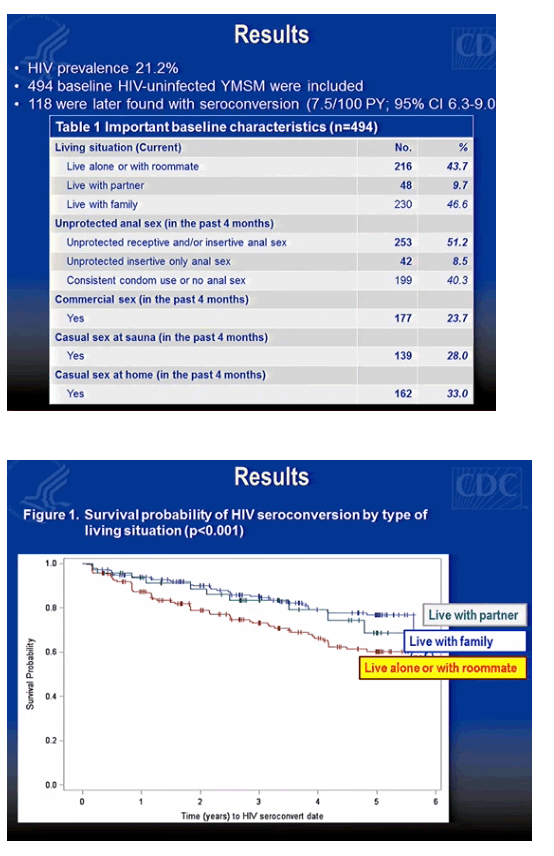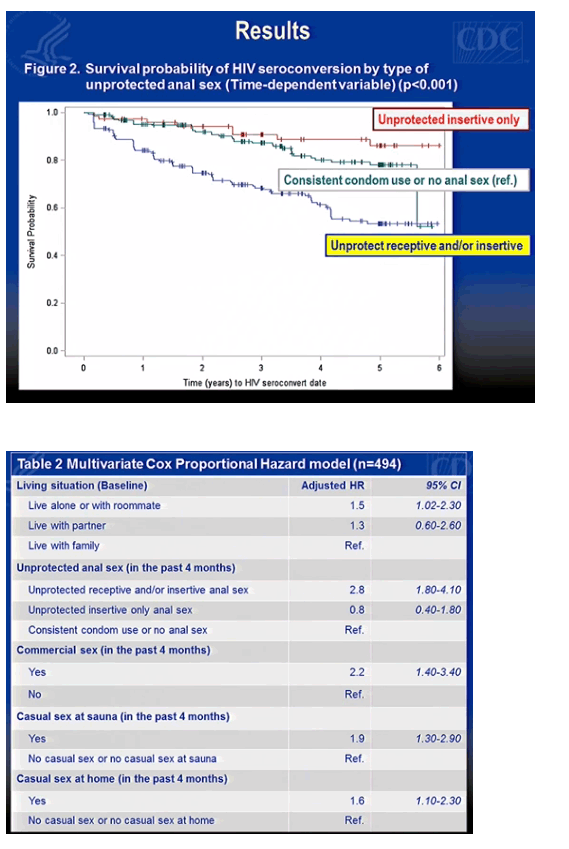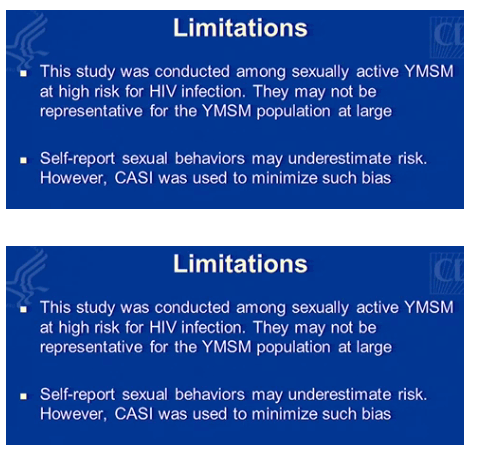 |
 |
 |
| |
Incidence and risk factors of HIV-infection among young men who have sex with men in Bangkok, Thailand
|
| |
| |
......."worldwide HIV epidemic has been declining in heterosexual population but increasing among MSM.....previous Thailand bi-annual HIV surveillances showed increased HIV prevalence among YMSM (15-22) from 13% in 2003 to 22% in 2005....previous analysis of the Bangkok MSM Cohort Study (MSCS) showed YMSM were having higher HIV incidence than their older counterparts (8.8/100 PY (18-21) vs 3.7/100 PY (>30)".....previous research showed high level of risk bahavior(inconsistent condom use/unprotected anal sex).....objective of this study: estimate HIV incidence among YMSM in BMCS/to examine risk factors associated with HIV-infection among YMSM in BMCS.......Results - HIV prevalence 21% (YMSM 18-24).....494 baseline HIV-unifected were included, 118 later found with seroconversion (7.5/100 PY; 95% CI 6.3-9.0)....of these 118, at baseline 60% had unprotected receptive and/or insertive anal sex (see Table 1 below)/the risk was about 3 times higher to get HIV.....those with unprotected receptive and/or insertive sex got HIV more & faster than those who used condoms consistently & those with unprotected insertive sex only .....those who engaged in commercial sex got HIV faster & were more likely to seroconvert/about 2 times higher chance to get HIV vs those who did not engage in commercial sex, as well those who lived alone or with roommate seroconvert faster vs those who lived with a partner or lived with family.....and those who had casual sex at sauna had about 2 times greater chance to get HIV & as well got HIV faster
Reported by Jules Levin
IAC Melbourne 2014

Presented by Sarika Pattanasin (Thailand).
W. Thienkrua1, S. Pattanasin1, N. Promda1, S. Winaitham1, W. Sukwicha1, T. Chemnasiri1, S. Chaikummao1, A. Varangrat1, P. Sirivongrangson2, T.H. Holtz1,3
1Thailand Ministry of Public Health - U.S. CDC Collaboration, Nonthaburi, Thailand, 2Ministry of Public Health, Department of Disease Control, Nonthaburi, Thailand, 3U.S. Centers for Disease Control and Prevention, Division of HIV/AIDS Prevention, Atlanta, United States
Background: Formative research by our program among young (18-24 years old) men who have sex with men (YMSM) in Bangkok revealed misconceptions that likely influence HIV risk perception among YMSM, and subsequent safe sex practices. These findings led us to estimate incidence density, and examine risk factors for HIV infection among YMSM enrolled in the Bangkok MSM Cohort Study.
Methods: Between 2006-2010, Thai MSM, age 18 years and older from the Bangkok metropolitan area, were enrolled into a cohort study and followed every four months for 60 months. HIV testing was routinely performed at every visit on oral fluid, with serologic confirmation of all reactive specimens and all non-reactive specimens obtained after February 2010. At each visit, respondents were asked about sexual and drug use behaviors in the preceding four months using audio computer-assisted self-interview. We calculated incidence per 100 Person Years (PY) by survival analysis, and determined risk factors for HIV infection using Cox regression analyses.
Results: Of 1,744 participants enrolled, 712 (41%) were YMSM with a baseline HIV-prevalence of 21% (n=151). Of the remaining 561 participants, 67 were excluded due to missing data. Of the 494 YMSM for whom data were available for analyses, median age was 22 years (IQR: 20-23 years), 295 (60%) reported unprotected anal intercourse at baseline, and 214 (43%) had basic HIV knowledge. Respondents identified themselves as being at relatively moderate risk for infection with HIV/STI in the future. Overall incidence density was 7.5 per 100 PY. Multivariate risk factors for HIV-incidence were reported in the last four months: unprotected receptive anal intercourse (Adjusted Hazard Ratio, AHR, 2.8: 95% Confidence Interval, CI: 1.8-4.1), being paid for sex (AHR 2.2; 95% CI: 1.4-3.4), having a casual sexual encounter at a sauna (AHR 1.9; 95% CI: 1.3-2.9), or at home (AHR 1.6; 95% CI: 1.06-2.3), and living alone or with a roommate (AHR 1.5; 95% CI: 1.02-2.3). (See Table 2 below)
Conclusions: Estimated HIV prevalence and incidence density among YMSM in Bangkok are high. Combination HIV prevention interventions that reduce HIV transmission during unprotected receptive anal intercourse, and education programs for skill-based training, are urgently needed for YMSM in Bangkok.
WEBCAST: http://pag.aids2014.org/flash.aspx?pid=1070


Bangkok MSM Cohort Study
(BMCS).....http://www.cdc.gov/mmwr/preview/mmwrhtml/mm6225a2.htm






|
| |
|
 |
 |
|
|